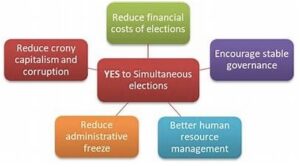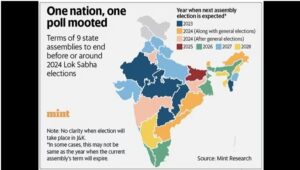Drop the bad idea of simultaneous elections
Relevance: GS Paper – 2, Elections, Federalism, Government Policies & Interventions, Indian Constitution, Constitutional Bodies
Tags: #SimultaneousElection, #Election #Polls #onenationoneelection #GS Paper 2
Why in the news?
In recent weeks, there has been increasing discussion about the possibility of having national and State elections at the same time, popularly known as ‘one nation, one election’ which led to the formation of a committee, helmed by a former President of India, Ram Nath Kovind, to determine how this might be implemented, and what manner of constitutional changes might be required to make it a legal reality, have generated further debate.
Arguments for Simultaneous elections
The primary arguments in favor of simultaneous elections are twofold:
- First, that it will decrease the costs of conducting elections (and of electioneering); and
- Second, it will free up political parties from being in ‘permanent campaign mode’, and allow them to focus on governance (and, for that matter, constructive opposition) for a five-year period.
Benefits of “one nation, one election”
| Benefit | Description |
| Reducing Election Expenditure | Conducting all elections simultaneously minimizes expenses on logistics, security, and campaigning. |
| Better Governance | Simultaneous elections allow elected governments to focus on governance rather than preparing for the next election. It will help in streamlining the election cycle to avoid policy disruptions due to the Model Code of Conduct |
| Voter Convenience | Ensures voters are not subjected to multiple rounds of voting, leading to better turnout and voter convenience. |
| Reduced Security Concerns | Conducting elections together reduces overall security concerns and enhances security setup across the country. |
| Level Playing Field | Provides a level playing field for all parties and candidates, promoting fairness and transparency in elections. |
| Reduced Impact on Education | Simultaneous elections reduce the impact on the education sector, as fewer teachers are involved in the electoral process. |
Challenges of “One Nation, One Election”
| Challenge | Description |
| Constitutional Challenges | Requires constitutional amendments, necessitating consensus among political parties and states, a complex and lengthy process. |
| Anti-federal | Assembly elections focus on local issues, and combining them with general elections may overshadow regional narratives. |
| Logistical challenges | Conducting all elections simultaneously involves logistical arrangements, security deployment, voter rolls, and polling booth management, leading to administrative difficulties. |
| Need for approximately 30 lakh electronic voting machines (EVMs) and voter-verified paper audit trail (VVPAT) machines | |
| Possibility of Domination by National Parties | Simultaneous elections may favour national parties with more resources, potentially marginalizing regional parties and issues. |
| Impact on Democracy | Voters may struggle to engage with all issues simultaneously, potentially leading to uninformed choices and undermining the democratic process. |
International Examples: Simultaneous Elections are successfully held in South Africa (national and provincial), and Sweden (including local elections as well on the same day).
Conclusion
- Therefore, it is clear that the administrative benefits from simultaneous elections are overstated at best, and non-existent at worst.
- However, the costs, both in the implementation and in the concept itself, are significant and create non-trivial risks when it comes to protecting and preserving the federal and democratic design of the Constitution.
- These, therefore, are good reasons why the idea is a bad one, and ought not to be acted upon.
Source: The Hindu
Mains Question
In view of the idea of holding simultaneous elections to the Lok Sabha and State Legislative Assemblies, discuss the advantages in its implementation and the concerns that it raises.





